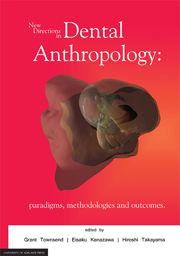Book contents
- Frontmatter
- Foreword
- Contents
- 1 Modelling the complexity of the dentition
- 2 New approaches to dental anthropology based on the study of twins
- 3 Genes for teeth — drawing inference from family data
- 4 Do feeding practices, gestation length, and birth weight affect the timing of emergence of the first primary tooth?
- 5 Sexual dimorphism in the primary and permanent dentitions of twins: an approach to clarifying the role of hormonal factors
- 6 Dental crown and arch size in Europeans and Australian Aboriginals
- 7 Sex determination from maxillary and mandibular canines of the Filipino population
- 8 Non-metric dental characteristics in Papua New Guinea Highlanders and their association with molar reduction
- 9 The Main Occluding Area between opposing teeth during chewing: a comparison between Australians and Japanese
- 10 “Mineral Maintenance” of dental structures in caries and erosive tooth wear: an holistic model
- 11 Emerging techniques for the analysis of tooth wear
Foreword
Published online by Cambridge University Press: 05 May 2013
- Frontmatter
- Foreword
- Contents
- 1 Modelling the complexity of the dentition
- 2 New approaches to dental anthropology based on the study of twins
- 3 Genes for teeth — drawing inference from family data
- 4 Do feeding practices, gestation length, and birth weight affect the timing of emergence of the first primary tooth?
- 5 Sexual dimorphism in the primary and permanent dentitions of twins: an approach to clarifying the role of hormonal factors
- 6 Dental crown and arch size in Europeans and Australian Aboriginals
- 7 Sex determination from maxillary and mandibular canines of the Filipino population
- 8 Non-metric dental characteristics in Papua New Guinea Highlanders and their association with molar reduction
- 9 The Main Occluding Area between opposing teeth during chewing: a comparison between Australians and Japanese
- 10 “Mineral Maintenance” of dental structures in caries and erosive tooth wear: an holistic model
- 11 Emerging techniques for the analysis of tooth wear
Summary
This book contains papers arising from a symposium held during a combined meeting of The International Union of Anthropological and Ethnological Sciences (IUAES), The Australian Anthropological Society (AAS) and The Association of Social Anthropologists of Aotearoa New Zealand at the University of Western Australia from July 5-8th, 2011. It follows on from a recently published Special Issue Supplement of Archives of Oral Biology, Volume 54, December 2009 that contains papers from an International Workshop on Oral Growth and Development held in Liverpool in 2007 and edited by Professor Alan Brook. Together, these two publications provide a comprehensive overview of state-of-the-art approaches to study dental development and variation, and open up opportunities for future collaborative research initiatives, a key aim of the International Collaborating Network in Oro-facial Genetics and Development that was founded in Liverpool in 2007.
The aim of the symposium held at The University of Western Australia in 2011 was to emphasise some of the powerful new strategies offered by the science of dental anthropology to elucidate the historical lineage of human groups and also to reconstruct environmental factors that have acted on the teeth by analysing dental morphological features. In recent years, migration, as well as increases and decreases in the size of different human populations, have been evident as a result of globalisation. Dental features are also changing associated with changes in nutritional status, different economic or social circumstances, and intermarriage between peoples. Dental anthropological studies have explored these changes with the use of advanced techniques and refined methodologies. New paradigms are also evolving in the field of dental anthropology.
- Type
- Chapter
- Information
- New Directions in Dental AnthropologyParadigms, Methodologies and Outcomes, pp. v - viiPublisher: The University of Adelaide PressPrint publication year: 2012
- 1
- Cited by

